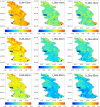Soil moisture estimation by assimilating L-band microwave brightness temperature with geostatistics and observation localization
- PMID: 25635771
- PMCID: PMC4312007
- DOI: 10.1371/journal.pone.0116435
Soil moisture estimation by assimilating L-band microwave brightness temperature with geostatistics and observation localization
Abstract
The observation could be used to reduce the model uncertainties with data assimilation. If the observation cannot cover the whole model area due to spatial availability or instrument ability, how to do data assimilation at locations not covered by observation? Two commonly used strategies were firstly described: One is covariance localization (CL); the other is observation localization (OL). Compared with CL, OL is easy to parallelize and more efficient for large-scale analysis. This paper evaluated OL in soil moisture profile characterizations, in which the geostatistical semivariogram was used to fit the spatial correlated characteristics of synthetic L-Band microwave brightness temperature measurement. The fitted semivariogram model and the local ensemble transform Kalman filter algorithm are combined together to weight and assimilate the observations within a local region surrounding the grid cell of land surface model to be analyzed. Six scenarios were compared: 1_Obs with one nearest observation assimilated, 5_Obs with no more than five nearest local observations assimilated, and 9_Obs with no more than nine nearest local observations assimilated. The scenarios with no more than 16, 25, and 36 local observations were also compared. From the results we can conclude that more local observations involved in assimilation will improve estimations with an upper bound of 9 observations in this case. This study demonstrates the potentials of geostatistical correlation representation in OL to improve data assimilation of catchment scale soil moisture using synthetic L-band microwave brightness temperature, which cannot cover the study area fully in space due to vegetation effects.
Conflict of interest statement
Figures







References
-
- Rigon R, Bertoldi G, Over TM (2006) GEOtop: A distributed hydrological model with coupled water and energy budgets. Journal of Hydrometeorology 7: 371–388.
-
- Crow WT, Kustas WP, Prueger JH (2008) Monitoring root-zone soil moisture through the assimilation of a thermal remote sensing-based soil moisture proxy into a water balance model. Remote Sensing of Environment 112: 1268–1281.
-
- Reichle RH, Crow WT, Koster RD, Sharif HO, Mahanama SPP (2008) Contribution of soil moisture retrievals to land data assimilation products. Geophysical Research Letters 35.
-
- Entekhabi D, Njoku EG, O’Neill PE, Kellogg KH, Crow WT, et al. (2010) The Soil Moisture Active Passive (SMAP) Mission. Proceedings of the IEEE 98: 704–716.
-
- Kerr YH, Waldteufel P, Wigneron JP, Delwart S, Cabot F, et al. (2010) The SMOS Mission: New Tool for Monitoring Key Elements ofthe Global Water Cycle. Proceedings of the IEEE 98: 666–687.
Publication types
MeSH terms
Substances
LinkOut - more resources
Full Text Sources
Other Literature Sources

